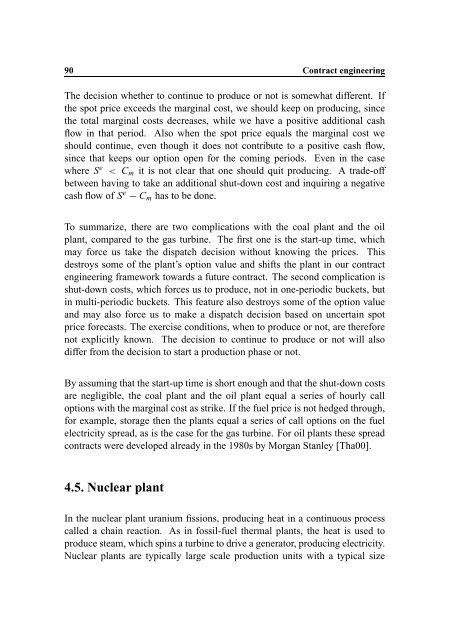Hedging Strategy and Electricity Contract Engineering - IFOR
Hedging Strategy and Electricity Contract Engineering - IFOR
Hedging Strategy and Electricity Contract Engineering - IFOR
Create successful ePaper yourself
Turn your PDF publications into a flip-book with our unique Google optimized e-Paper software.
90 <strong>Contract</strong> engineering<br />
The decision whether to continue to produce or not is somewhat different. If<br />
the spot price exceeds the marginal cost, we should keep on producing, since<br />
the total marginal costs decreases, while we have a positive additional cash<br />
flow in that period. Also when the spot price equals the marginal cost we<br />
should continue, even though it does not contribute to a positive cash flow,<br />
since that keeps our option open for the coming periods. Even in the case<br />
where S e C m it is not clear that one should quit producing. A trade-off<br />
¬<br />
between having to take an additional shut-down cost <strong>and</strong> inquiring a negative<br />
cash flow of S e C m has to be done.<br />
To summarize, there are two complications with the coal plant <strong>and</strong> the oil<br />
plant, compared to the gas turbine. The first one is the start-up time, which<br />
may force us take the dispatch decision without knowing the prices. This<br />
destroys some of the plant’s option value <strong>and</strong> shifts the plant in our contract<br />
engineering framework towards a future contract. The second complication is<br />
shut-down costs, which forces us to produce, not in one-periodic buckets, but<br />
in multi-periodic buckets. This feature also destroys some of the option value<br />
<strong>and</strong> may also force us to make a dispatch decision based on uncertain spot<br />
price forecasts. The exercise conditions, when to produce or not, are therefore<br />
not explicitly known. The decision to continue to produce or not will also<br />
differ from the decision to start a production phase or not.<br />
By assuming that the start-up time is short enough <strong>and</strong> that the shut-down costs<br />
are negligible, the coal plant <strong>and</strong> the oil plant equal a series of hourly call<br />
options with the marginal cost as strike. If the fuel price is not hedged through,<br />
for example, storage then the plants equal a series of call options on the fuel<br />
electricity spread, as is the case for the gas turbine. For oil plants these spread<br />
contracts were developed already in the 1980s by Morgan Stanley [Tha00].<br />
4.5. Nuclear plant<br />
In the nuclear plant uranium fissions, producing heat in a continuous process<br />
called a chain reaction. As in fossil-fuel thermal plants, the heat is used to<br />
produce steam, which spins a turbine to drive a generator, producing electricity.<br />
Nuclear plants are typically large scale production units with a typical size
















